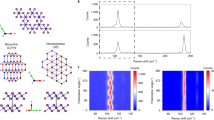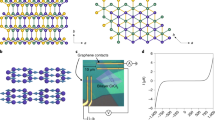Abstract
The physical properties of two-dimensional van der Waals crystals can be sensitive to interlayer coupling. For two-dimensional magnets1,2,3, theory suggests that interlayer exchange coupling is strongly dependent on layer separation while the stacking arrangement can even change the sign of the interlayer magnetic exchange, thus drastically modifying the ground state4,5,6,7,8,9,10. Here, we demonstrate pressure tuning of magnetic order in the two-dimensional magnet CrI3. We probe the magnetic states using tunnelling8,11,12,13 and scanning magnetic circular dichroism microscopy measurements2. We find that interlayer magnetic coupling can be more than doubled by hydrostatic pressure. In bilayer CrI3, pressure induces a transition from layered antiferromagnetic to ferromagnetic phase. In trilayer CrI3, pressure can create coexisting domains of three phases, one ferromagnetic and two antiferromagnetic. The observed changes in magnetic order can be explained by changes in the stacking arrangement. Such coupling between stacking order and magnetism provides ample opportunities for designer magnetic phases and functionalities.
This is a preview of subscription content, access via your institution
Access options
Access Nature and 54 other Nature Portfolio journals
Get Nature+, our best-value online-access subscription
$29.99 / 30 days
cancel any time
Subscribe to this journal
Receive 12 print issues and online access
$259.00 per year
only $21.58 per issue
Buy this article
- Purchase on Springer Link
- Instant access to full article PDF
Prices may be subject to local taxes which are calculated during checkout




Similar content being viewed by others
Data availability
The data that support the findings of this study are available from the corresponding author upon reasonable request.
References
Gong, C. et al. Discovery of intrinsic ferromagnetism in two-dimensional van der Waals crystals. Nature 546, 265–269 (2017).
Huang, B. et al. Layer-dependent ferromagnetism in a van der Waals crystal down to the monolayer limit. Nature 546, 270–273 (2017).
Burch, K. S., Mandrus, D. & Park, J.-G. Magnetism in two-dimensional van der Waals materials. Nature 563, 47–52 (2018).
Jiang, P. et al. Stacking tunable interlayer magnetism in bilayer CrI3. Phys. Rev. B 99, 144401 (2019).
Soriano, D., Cardoso, C. & Fernández-Rossier, J. Interplay between interlayer exchange and stacking in CrI3 bilayers. Solid State Commun. 299, 113662 (2019).
Sivadas, N., Okamoto, S., Xu, X., Fennie, C. J. & Xiao, D. Stacking-dpendent magnetism in bilayer CrI3. Nano Lett. 18, 7658–7664 (2018).
Jang, S. W., Jeong, M. Y., Yoon, H., Ryee, S. & Han, M. J. Microscopic understanding of magnetic interactions in bilayer CrI3. Phys. Rev. Mater. 3, 031001 (2019). (R).
Wang, Z. et al. Very large tunneling magnetoresistance in layered magnetic semiconductor CrI3. Nat. Commun. 9, 2516 (2018).
Cao, H. B. et al. Low-temperature crystal and magnetic structure of RuCl3. Phys. Rev. B 93, 134423 (2016).
Subhan, F., Khan, I. & Hong, J. Pressure-induced ferromagnetism and enhanced perpendicular magnetic anisotropy of bilayer CrI3. J. Phys. Condens. Matter 31, 355001 (2019).
Song, T. et al. Giant tunneling magnetoresistance in spin-filter van der Waals heterostructures. Science 360, 1214–1218 (2018).
Klein, D. R. et al. Probing magnetism in 2D van der Waals crystalline insulators via electron tunneling. Science 360, 1218–1222 (2018).
Kim, H. H. et al. One million percent tunnel magnetoresistance in a magnetic van der Waals heterostructure. Nano Lett. 18, 4885–4890 (2018).
Klein, D. R. et al. Enhancement of interlayer exchange in an ultrathin two-dimensional magnet. Nat. Phys. https://doi.org/10.1038/s41567-019-0651-0 (2019).
McGuire, M. A., Dixit, H., Cooper, V. R. & Sales, B. C. Coupling of crystal structure and magnetism in the layered, ferromagnetic insulator CrI3. Chem. Mater. 27, 612–620 (2015).
Sun, Z. et al. Giant nonreciprocal second-harmonic generation from antiferromagnetic bilayer CrI3. Nature 572, 497–501 (2019).
Thiel, L. et al. Probing magnetism in 2D materials at the nanoscale with single-spin microscopy. Science 364, 973–976 (2019).
Yankowitz, M. et al. Dynamic band-structure tuning of graphene moiré superlattices with pressure. Nature 557, 404–408 (2018).
Ci, P. et al. Quantifying van der Waals interactions in layered transition metal dichalcogenides from pressure-enhanced valence band splitting. Nano Lett. 17, 4982–4988 (2017).
Zhao, Z. et al. Pressure induced metallization with absence of structural transition in layered molybdenum diselenide. Nat. Commun. 6, 7312 (2015).
Yankowitz, M. et al. Tuning superconductivity in twisted bilayer graphene. Science 363, 1059–1064 (2019).
Sun, Y. et al. Effects of hydrostatic pressure on spin-lattice coupling in two-dimensional ferromagnetic Cr2Ge2Te6. Appl. Phys. Lett. 112, 072409 (2018).
Son, S. et al. Bulk properties of the van der Waals hard ferromagnet VI3. Phys. Rev. B 99, 041402 (2019).
Lin, Z. et al. Pressure-induced spin reorientation transition in layered ferromagnetic insulator Cr2Ge2Te6. Phys. Rev. Mater. 2, 051004 (2018).
Mondal, S. et al. Effect of hydrostatic pressure on ferromagnetism in two-dimensional CrI3. Phys. Rev. B 99, 180407 (2019).
Gopinadhan, K. et al. Extremely large magnetoresistance in few-layer graphene/boron–nitride heterostructures. Nat. Commun. 6, 8337 (2015).
Djurdjić-Mijin, S. et al. Lattice dynamics and phase transition in CrI3 single crystals. Phys. Rev. B 98, 104307 (2018).
Webster, L., Liang, L. & Yan, J.-A. Distinct spin–lattice and spin–phonon interactions in monolayer magnetic CrI3. Phys. Chem. Chem. Phys. 20, 23546–23555 (2018).
Tong, Q., Liu, F., Xiao, J. & Yao, W. Skyrmions in the moiré of van der Waals 2D magnets. Nano Lett. 18, 7194–7199 (2018).
Li, T. et al. Pressure-controlled interlayer magnetism in atomically thin CrI3. Nat. Mater. https://doi.org/10.1038/s41563-019-0506-1 (2019).
Acknowledgements
We thank S. Wu and W. Wu for the insightful discussion. This work was mainly supported by the Department of Energy, Basic Energy Sciences, Materials Sciences and Engineering Division, Pro-QM EFRC (grant no. DE-SC0019443). Device fabrication and quantum tunnelling measurement were partially supported by NSF MRSEC (grant no. 1719797), and magnetic circular dichroism measurement was partially supported by the Department of Energy, Basic Energy Sciences, Materials Sciences and Engineering Division (grant no. E-SC0018171). The material synthesis performed at the University of Washington was partially supported by the Gordon and Betty Moore Foundation’s EPiQS Initiative (grant no. GBMF6759 to J.-H.C.). M.A.M. was supported by the US Department of Energy, Office of Science, Basic Energy Sciences, Materials Sciences and Engineering Division. K.W. and T.T. acknowledge support from the Elemental Strategy Initiative conducted by MEXT, Japan, A3 Foresight by JSPS and CREST (grant no. JPMJCR15F3) and JST. A portion of this work was performed at the National High Magnetic Field Laboratory, which is supported by National Science Foundation Cooperative Agreement (no. DMR-1644779) and the State of Florida. X.X. and J.-H.C. acknowledge support from the State of Washington-funded Clean Energy Institute. X.X. also acknowledges support from the Boeing Distinguished Professorship in Physics.
Author information
Authors and Affiliations
Contributions
X.X., T.S., M.Y., C.R.D. and D.X. conceived the experiment. T.S. and Z.F. fabricated and characterized the devices, assisted by M.Y. and B.S. T.S., Z.F. and M.Y. performed the high-pressure measurements, assisted by D.G. T.S. performed magnetic circular dichroism and Raman measurements. K.H. and Q.Z. assisted in Raman measurement. T.S., Z.F., X.X., D.X., T.C. and D.H.C. analysed and interpreted the results. M.M., Z.L., Q.J. and J.-H.C. independently synthesized and characterized the bulk CrI3 crystals. T.S., X.X., D.H.C., D.X. and Z.F. wrote the paper with input from all authors. All authors discussed the results.
Corresponding author
Ethics declarations
Competing interests
The authors declare no competing interests.
Additional information
Publisher’s note Springer Nature remains neutral with regard to jurisdictional claims in published maps and institutional affiliations.
Supplementary information
Supplementary Information
Supplementary Figs. 1–6.
Rights and permissions
About this article
Cite this article
Song, T., Fei, Z., Yankowitz, M. et al. Switching 2D magnetic states via pressure tuning of layer stacking. Nat. Mater. 18, 1298–1302 (2019). https://doi.org/10.1038/s41563-019-0505-2
Received:
Accepted:
Published:
Issue Date:
DOI: https://doi.org/10.1038/s41563-019-0505-2
This article is cited by
-
High-throughput computational stacking reveals emergent properties in natural van der Waals bilayers
Nature Communications (2024)
-
Magnetic properties of van der Waals ferromagnet \(\hbox {VI}_{3}\) and \(\hbox {CrI}_{3}\): a renormalization group approach
Indian Journal of Physics (2024)
-
Evidence of non-collinear spin texture in magnetic moiré superlattices
Nature Physics (2023)
-
Emergent layer stacking arrangements in c-axis confined MoTe2
Nature Communications (2023)
-
Control of magnetic states and spin interactions in bilayer CrCl3 with strain and electric fields: an ab initio study
Scientific Reports (2023)



